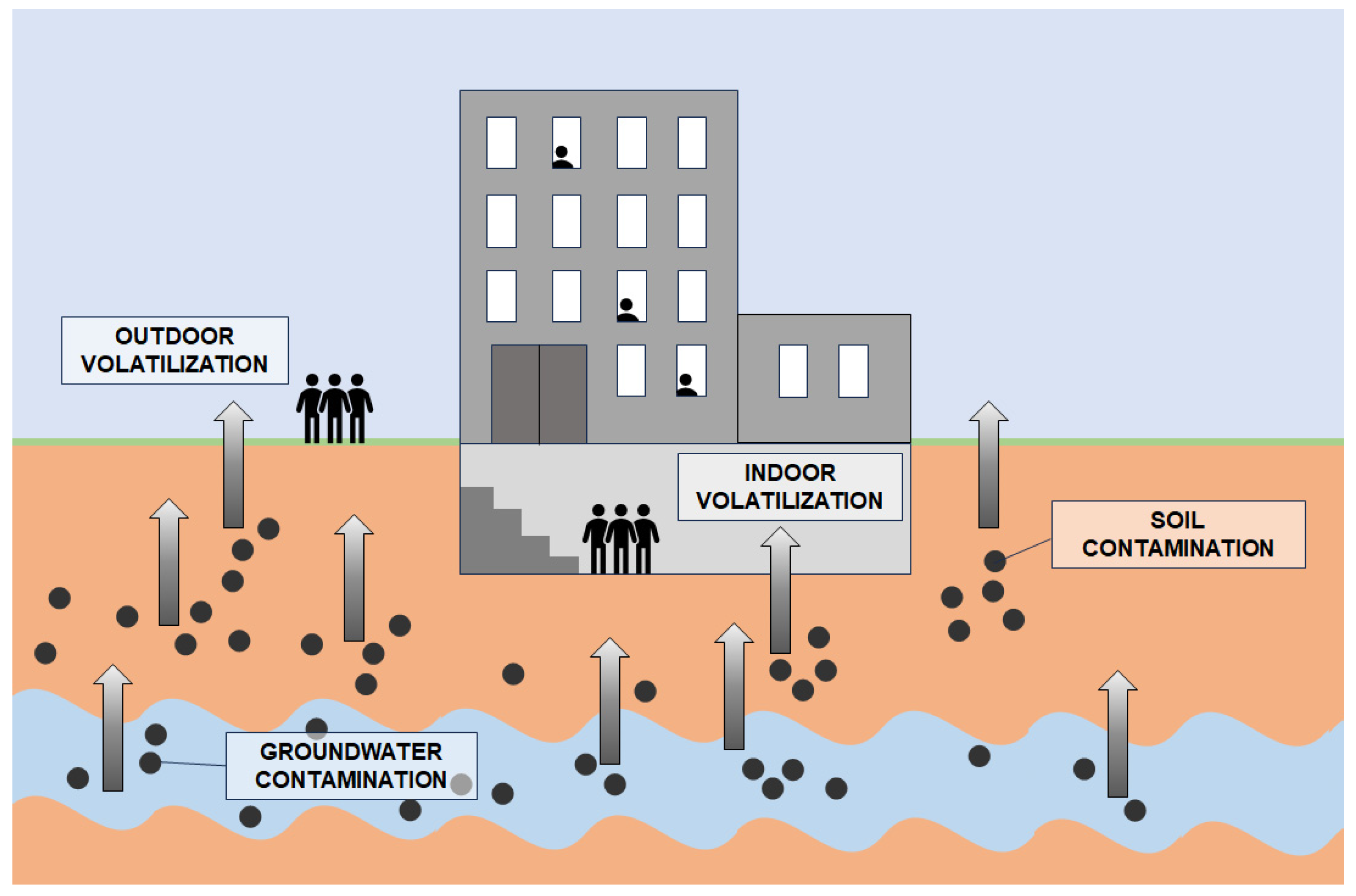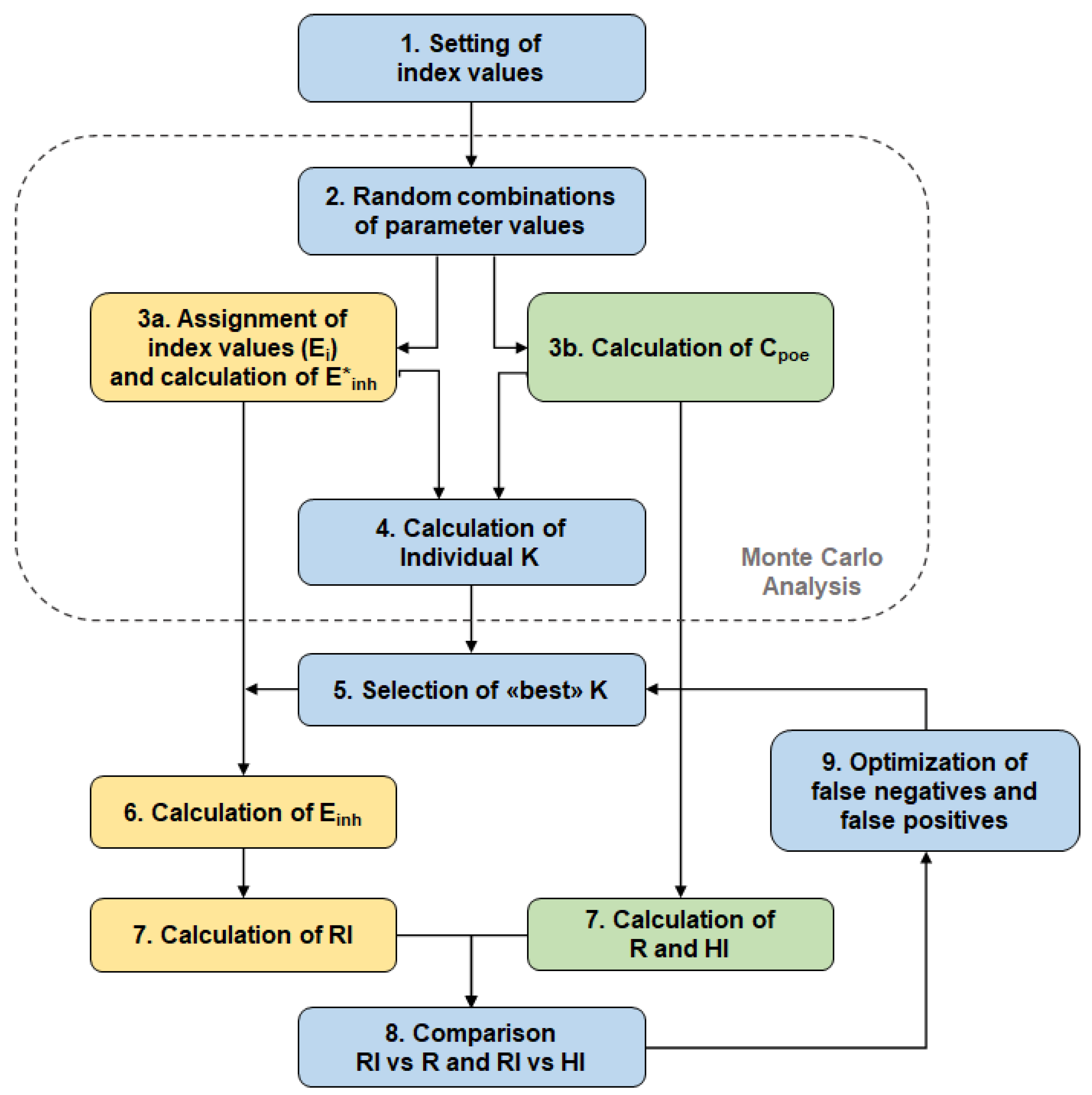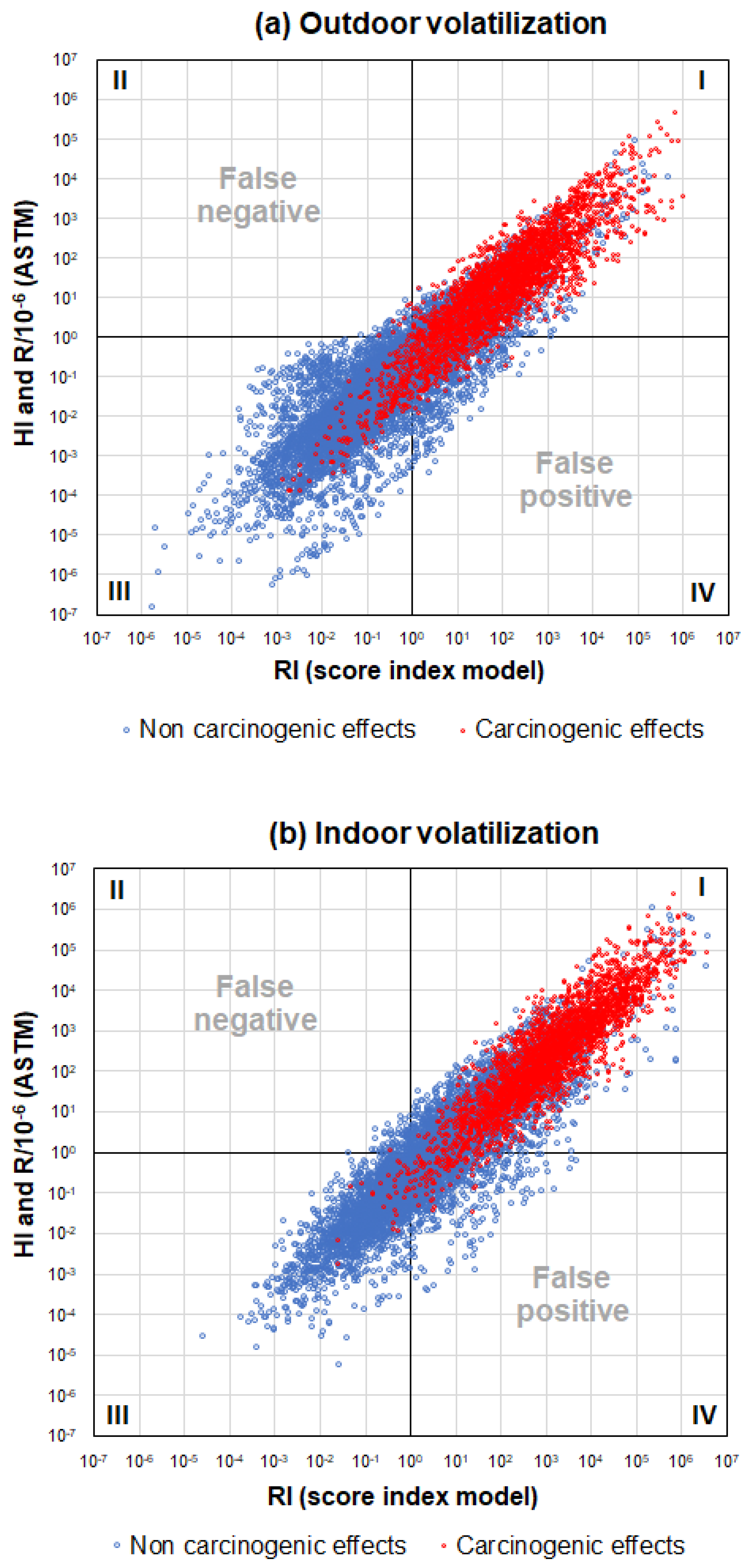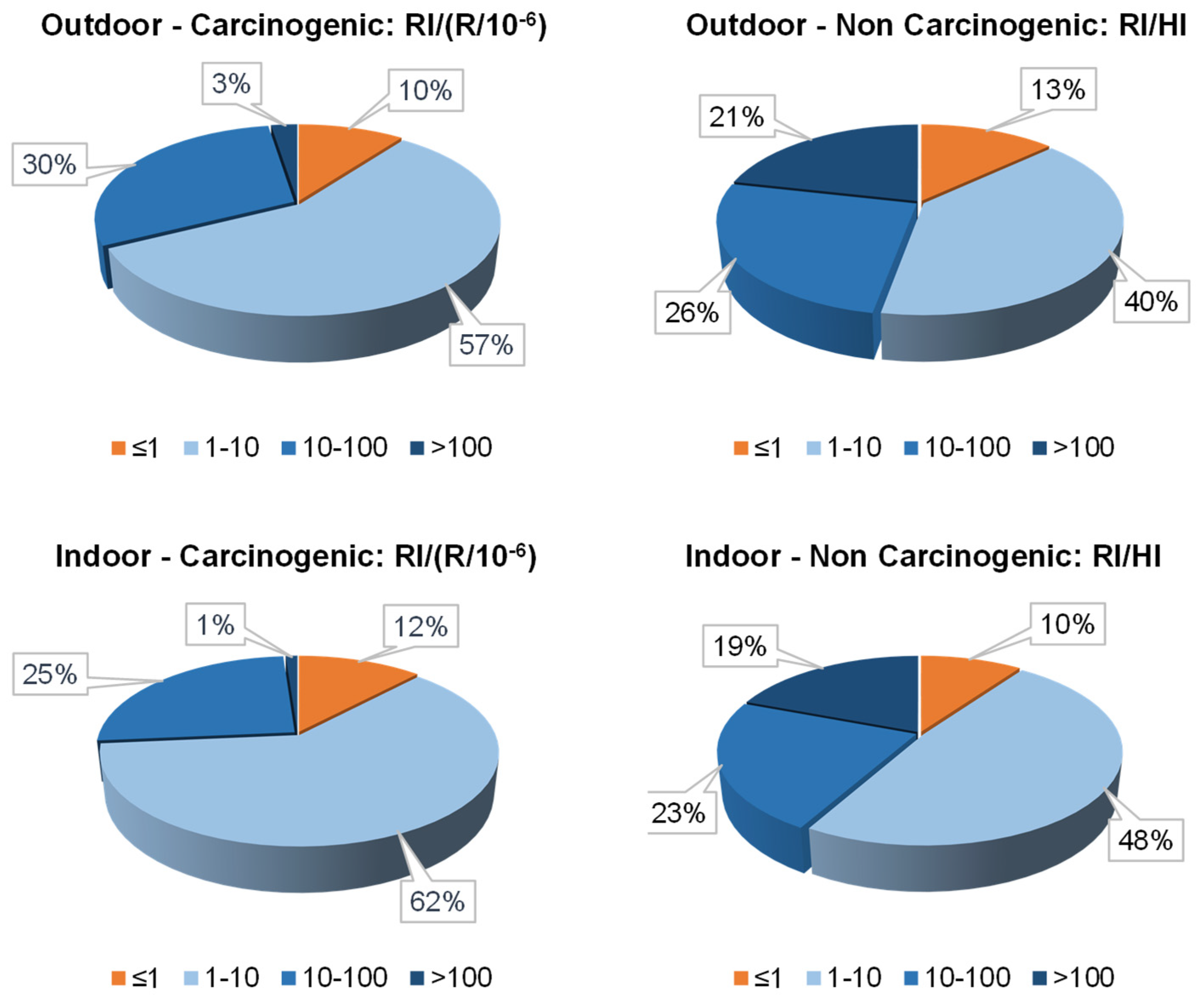A Score Index System for a Semi-Quantitative Assessment of Inhalation Risks at Contaminated Sites
Abstract
:1. Introduction
2. Methods
2.1. Standard RBCA Tier 2 Procedure
2.2. Developed Score Index System
2.2.1. Risk Index
2.2.2. Concentration in Air at the Point of Exposure
Site-Specific Indexes for the Outdoor Volatilization Pathway
- EM is the index related to the “contaminated environmental matrix” parameter. Its value depends on the depth of the contamination: surface soil (0–1 m b.g.s), subsurface soil (>1 m b.g.s) or groundwater, according to the RBCA approach defined by U.S. EPA [5];
- EC is the index related to the “contaminant concentration at source” parameter. Its value is equal to the representative concentration value at source, expressed as mg/kgsoil or mg/Lwater;
- EV is the index related to the “contaminant volatility” parameter. It is calculated by Equation (9) for contamination sources in surface and subsurface soil or by Equation (10) for contamination sources in groundwater:where H [-] is the dimensionless Henry’s law constant, Da [cm2/s] is the diffusion coefficient in air, Ks [(mg/kg)/(mg/L)] is the soil–water sorption coefficient. Ks is equal to Kd for inorganic contaminants (it can depend on the pH value of the soil), or to Koc × foc for organic compounds (Kd [L/kg] is the soil/water distribution coefficient, Koc [L/kg] the organic carbon-water sorption coefficient and foc [g/g.] is the fraction of organic carbon in the soil). All these terms depend on the properties, with the exception of Ks that, for organic contaminants, also depends on the fraction of organic carbon in the soil (foc);
- ET is the index related to the “soil type” parameter. It assumes different values according to the United States Department of Agriculture (USDA) classification for the soil type, following the approach defined by U.S. EPA [5];
- ES is the index related to the “source width” parameter. Its value is assigned by choosing, among three width ranges, the range where the site-specific contamination source width falls;
- EW is the index related to the “wind speed” parameter. Its value is assigned by choosing among three wind speed ranges, the range where the site-specific representative value falls;
- KOV is the outdoor scaling factor.
Site-Specific Indices for the Indoor Volatilization Pathway
- EM, EC, EV and ET are the same of the outdoor volatilization pathway;
- EH is the index related to the “enclosed-space volume/infiltration area ratio” parameter. Its value depends on the building type (basement, standard building and warehouse);
- EER is the index related to the “enclosed-space air exchange rate” parameter. Its value is assigned by choosing, among three air exchange rate ranges, the range where the site-specific value falls;
- Eη is the index related to the “areal fraction of the building’s cracks” parameter. Its value is assigned by choosing between three classes of structural floor conditions, corresponding to three ranges of the areal fraction of cracks;
- KIV is the indoor scaling factor.
2.2.3. Determination of the Scaling Factor (K)
- A first tentative index value for each class of the selected parameters was set, then the calibration followed an iterative procedure;
- For each selected parameter, a range/set of values (see Table 4) was defined, and 10,000 random combinations of these values were generated;
- For each combination:
- The corresponding index values Ei were assigned and the product of all relevant indexes E*inh was calculated;
- The Cpoe was calculated for outdoor and indoor pathways by Equations (S1)–(S6) in the Supplementary Material. For parameters not involved in the score index system, the default values set by the ASTM standard were adopted [14];
- For each combination, an individual scaling factor K was calculated as:For outdoor and indoor volatilization pathways, Equation (12) becomes, respectively:
- A tentative “best” K was chosen from the distribution of individual scaling factors;
- For each combination, the exposure index Einh (Equation (7)) was calculated using the tentative “best” K;
- For each combination, the risk index RI (Equation (4)) and the risk, R and HI, from the RBCA Tier 2 model (Equations (1) and (2)) were calculated. The exposure parameters adopted to calculate R and HI and the limit value in air (LV) for a worker exposure are shown in Table 1. The toxicological and chemical–physical parameters of different contaminants of concern are provided in the supplementary material (Table S4) and were taken from the database issued by U.S. EPA [35];
- RI was compared with R and HI, according to the criteria detailed below;
- Steps 5–8 were repeated until the choice of the final “best” K.
3. Results and Discussion
3.1. Validation of the Score Index System
3.2. Application of the Score Index System to a Case Study
- Aliphatics C5–C8 for the source of contamination in the unsaturated soil (ID 1);
- Aliphatics C9–C12, trichloroethylene, vinyl chloride, 1,1,2,2 tetrachloroethane, 1,1 dichloroethylene and 1,2 dichloropropane for the source of contamination in groundwater (ID 2a–2f).
4. Conclusions
Supplementary Materials
Author Contributions
Funding
Institutional Review Board Statement
Informed Consent Statement
Data Availability Statement
Conflicts of Interest
References
- Pasetto, R.; Martin-Olmedo, P.; Martuzzi, M.; Iavarone, I. Exploring available options in characterising the health impact of industrially contaminated sites. Ann. Ist. Super. Sanita 2011, 52, 476–482. [Google Scholar] [CrossRef]
- Swartjes, F.A.; Rutgers, M.; Lijzen, J.P.A.; Janssen, P.J.C.M.; Otte, P.F.; Wintersen, A.; Brand, E.; Posthuma, L. State of the art of contaminated site management in The Netherlands: Policy framework and risk assessment tools. Sci. Total Environ. 2012, 427–428, 1–10. [Google Scholar] [CrossRef] [PubMed]
- Pinedo, J.; Ibáñez, R.; Irabien, Á. A comparison of models for assessing human risks of petroleum hydrocarbons in polluted soils. Environ. Model. Softw. 2014, 55, 61–69. [Google Scholar] [CrossRef]
- Swartjes, F.A. Human health risk assessment related to contaminated land: State of the art. Environ. Geochem. Health 2015, 37, 651–673. [Google Scholar] [CrossRef] [PubMed]
- U.S. EPA. Soil Screening Guidance: User’s Guide; US Environmental Protection Agency: Washington, DC, USA, 1996.
- U.S. EPA. Risk Assessment Guidance for Superfund Volume I: Human Health Evaluation Manual (Part F, Supplemental Guidance for Inhalation Risk Assessment); EPA/540/1-89/002; Office of Superfund Remediation and Technology Innovation, Environmental Protection Agency: Washington, DC, USA, 2009.
- Wcisło, E.; Bronder, J.; Bubak, A.; Rodríguez-Valdés, E.; Gallego, J.L.R. Human health risk assessment in restoring safe and productive use of abandoned contaminated sites. Environ. Int. 2016, 94, 436–448. [Google Scholar] [CrossRef] [PubMed]
- U.S. EPA. Human Health Risk Assessment. 2023. Available online: https://www.epa.gov/risk/human-health-risk-assessment (accessed on 3 July 2023).
- U.S. EPA. OSWER Directive 9610.17 Use of Risk-Based Decision Making in UST Corrective Action Programs. 1 March 1995. Available online: https://www.epa.gov/sites/default/files/2014-02/documents/d9610.17.pdf (accessed on 3 July 2023).
- Sager, S.L. Risk Based Corrective Action (RBCA). In Encyclopedia of Toxicology; Elsevier: Amsterdam, The Netherlands, 2005; pp. 733–736. [Google Scholar] [CrossRef]
- Li, X.; Jiao, W.; Xiao, R.; Chen, W.; Liu, W. Contaminated sites in China: Countermeasures of provincial governments. J. Clean. Prod. 2017, 147, 485–496. [Google Scholar] [CrossRef]
- Ferguson, C.; Darmendrail, D.; Freier, K.; Jensen, B.K.; Jensen, J.; Kasamas, H.; Urzelai, A.; Vegter, J. Risk Assessment for Contaminated Sites in Europe. Volume 1. Scientific Basis; LQM Press: Nottingham, UK, 1998. [Google Scholar]
- E 1739-95; Standard Guide for Risk-Based Corrective Action Applied at Petroleum Release Sites. ASTM: West Conshohocken, PA, USA, 1995; (Re-approved 2015).
- E 2081-00; Standard Guide for Risk-Based Corrective Action. ASTM: West Conshohocken, PA, USA, 2000; (Re-approved 2015).
- Connor, J.A.; McHugh, T.E. Impact of Risk-Based Corrective Action (RBCA) on State LUST Corrective Action Programs. Hum. Ecol. Risk Assess. Int. J. 2002, 8, 573–589. [Google Scholar] [CrossRef]
- Baciocchi, R.; Berardi, S.; Verginelli, I. Human health risk assessment: Models for predicting the effective exposure duration of on-site receptors exposed to contaminated groundwater. J. Hazard. Mater. 2010, 181, 226–233. [Google Scholar] [CrossRef] [PubMed] [Green Version]
- Verginelli, I.; Baciocchi, R. Role of natural attenuation in modeling the leaching of contaminants in the risk analysis framework. J. Environ. Manag. 2013, 114, 395–403. [Google Scholar] [CrossRef] [PubMed]
- Wcisło, E.; Dlugosz, J.; Korcz, M. A Human Health Risk Assessment Software for Facilitating Management of Urban Contam. Sites A Case Study: Massa Site Tuscany Italy. Hum. Ecol. Risk Assess. Int. J. 2005, 11, 1005–1024. [Google Scholar] [CrossRef]
- Brand, E.; Otte, P.F.; Lijzen, J.P. CSOIL2000 an Exposure Model for Human Risk Assessment of Soil Contamination. RIVM Report 711701054/2007. Available online: https://rivm.openrepository.com/handle/10029/13385 (accessed on 1 April 2023).
- Environment Agency. CLEA Software Handbook Environment, Version 1.05; Environment Agency: Bristol, UK, 2009.
- Di Sante, M.; Mazzieri, F.; Fratalocchi, E.; Brianzoni, V.; Pasqualini, E. A possible approach for Tier 2 risk assessments of polluted sites: Framework, computer spreadsheet and application. Comput. Geotech. 2014, 56, 16–27. [Google Scholar] [CrossRef]
- Locatelli, L.; Binning, P.J.; Sanchez-Vila, X.; Søndergaard, G.L.; Rosenberg, L.; Bjerg, P.L. A simple contaminant fate and transport modelling tool for management and risk assessment of groundwater pollution from contaminated sites. J. Contam. Hydrol. 2019, 221, 35–49. [Google Scholar] [CrossRef] [PubMed]
- Mahammedi, C.; Mahdjoubi, L.; Booth, C.A.; Akram, H.; Butt, T.E. A systematic review of risk assessment tools for contaminated sites—Current perspectives and future prospects. Environ. Res. 2020, 191, 110180. [Google Scholar] [CrossRef] [PubMed]
- Di Sante, M.; Mazzieri, F.; Pasqualini, E. Assessment of the sanitary and environmental risks posed by a contaminated industrial site. J. Hazard. Mater. 2009, 171, 524–534. [Google Scholar] [CrossRef] [PubMed]
- Zhong, M.; Jiang, L.; Jia, X.; Liang, J. Health Risk Assessment on PAHs Contaminated Site—A Case Study in a Relocated Coke and Chemical Plant in Beijing. Procedia Environ. Sci. 2013, 18, 666–678. [Google Scholar] [CrossRef] [Green Version]
- Bardos, R.P.; Bone, B.D.; Boyle, R.; Evans, F.; Harries, N.D.; Howard, T.; Smith, J.W.N. The rationale for simple approaches for sustainability assessment and management in contaminated land practice. Sci. Total Environ. 2016, 563–564, 755–768. [Google Scholar] [CrossRef] [PubMed] [Green Version]
- Tickner, J.; Friar, J.; Creely, K.S.; Cherrie, J.W.; Pryde, D.E.; Kingston, J. The Development of the EASE Model. Ann. Occup. Hyg. 2005, 49, 103–110. [Google Scholar] [CrossRef] [PubMed]
- Tielemans, E.; Noy, D.; Schinkel, J.; Heussen, H.; Van Der Schaaf, D.; West, J.; Fransman, W. Stoffenmanager Exposure Model: Development of a Quantitative Algorithm. Ann. Occup. Hyg. 2008, 52, 443–454. [Google Scholar] [CrossRef] [PubMed]
- Landberg, H. The Use of Exposure Models in Assessing Occupational Exposure to Chemicals; Faculty of Medicine, Lund University: Lund, Sweden, 2018. [Google Scholar]
- Vincent, R.; Bonthoux, F.; Mallet, G.; Iparraguire, J.-F.; Rio, S. Méthodologie d’évaluation simplifiée du risque chimique. Hygiène sécurité du Trav. 2005, 9, 39–62. [Google Scholar]
- UNI—Italian National Standards Body. Technical Report UNI/TR 11707:2018—Assessment of the Worker Exposure to Chemicals. Survey into Predictive Models to Evaluate the Occupational Risk from Chemicals; UNI—Italian National Standards Body: Rome, Italy, 2018. [Google Scholar]
- Mangiapia, M.D.; Verginelli, I.; Baciocchi, R.; Bogliolo, M.P.; Berardi, S. Review of reference values for the assessment of inhalation risks for workers at industrial contaminated sites. Hum. Ecol. Risk Assess. Int. J. 2022, 28, 664–682. [Google Scholar] [CrossRef]
- D’Aprile, L.; Berardi, S. Identification and validation of sensitive parameters for site specific risk assessment at contaminated sites. In Proceedings of the 10th FKZ/TNO Conference on Contaminated Soils (CONSOIL 2008), Milan, Italy, 2–6 June 2008. [Google Scholar]
- ISPRA. Criteri Metodologici per l’applicazione dell’analisi Assoluta di Rischio ai Siti Contaminati—Rev.2-Appendice N: Analisi di Sensibilità; ISPRA: Rome, Italy, 2008. (In Italian)
- U.S. EPA. Toxicity and Chemical/Physical Properties for Regional Screening Level (RSL) of Chemical Contaminants at Superfund Sites. 2021. Available online: https://www.epa.gov/risk/regional-screening-levels-rsls-generic-tables (accessed on 12 October 2021).




| Symbol | Units | Value |
|---|---|---|
| ATc | Years | 70 |
| Atn | Years | 25 |
| EFd | Hours/day | 8 |
| EF | Days/year | 250 |
| ED | Years | 25 |
| Index | Selected Parameter | Parameter Classes | Index Values |
|---|---|---|---|
| EM | Contaminated environmental matrix | Surface soil | 10 |
| Subsurface soil | 5 | ||
| Groundwater | 1 | ||
| EC | Contaminant concentration at source | Soil concentration | |
| Groundwater concentration | |||
| EV | Contaminant volatility | Soil | |
| Groundwater | |||
| ET | Soil Type | Coarse Soil (Sand, Loamy Sand, Sandy Loam) | 50 |
| Medium Soil (Sandy Clay Loam, Loam, Silt Loam, Clay Loam, Silty Clay Loam, Silt, Sandy Clay) | 5 | ||
| Fine-grained Soil (Clay, Silty Clay) | 1 | ||
| ES | Source width | <50 m (small) | 1 |
| 50–250 m (medium) | 5 | ||
| >250 m (large) | 10 | ||
| EW | Wind speed | <1 m/s (low) | 5 |
| 1–3 m/s (medium) | 2 | ||
| >3 m/s (high) | 1 | ||
| Outdoor Exposure | |||
| Index | Selected Parameter | Parameter Classes | Index Values |
|---|---|---|---|
| EM | Contaminated environmental matrix | Surface soil | 5 |
| Subsurface soil | 2 | ||
| Groundwater | 1 | ||
| EC | Contaminant concentration at source | Soil concentration | |
| Groundwater concentration | |||
| EV | Contaminant volatility | Soil | |
| Groundwater | |||
| ET | Soil Type | Coarse Soil (Sand, Loamy Sand, Sandy Loam) | 3 |
| Medium Soil (Sandy Clay Loam, Loam, Silt Loam, Clay Loam, Silty Clay Loam, Silt, Sandy Clay) | 2 | ||
| Fine-grained Soil (Clay, Silty Clay) | 1 | ||
| EH | Enclosed-space volume/infiltration area ratio | <2 m (Basements) | 3 |
| 2–4 m (Standard) | 2 | ||
| >4 m (Warehouse) | 1 | ||
| EER | Enclosed-space air exchange rate | Low (<0.3 1/h) | 3 |
| Medium (0.3–1 1/h) | 2 | ||
| High (>1 1/h) | 1 | ||
| Eη | Areal fraction of cracks | Bad/No info (cracks > 1%) | 10 |
| Average (cracks = 0.1–1%) | 5 | ||
| Good (cracks < 0.1%) | 1 | ||
| Indoor Exposure | |||
| Selected Parameter | Unit | Range/Set of Values |
|---|---|---|
| Contaminated environmental matrix | - | 3 classes |
| Contaminant | - | 60 volatile chemicals (Henry’s constant H > 10−3) |
| Contaminant concentration at source | mg/kgsoil or mg/Lwater | 0.1–1000 |
| Soil type | - | 3 classes |
| Source width | m | 10–500 |
| Wind speed | m/s | 0.5–5 |
| Enclosed space volume/infiltration area ratio | m | 1–6 |
| Enclosed space air exchange rate | 1/s | 5.8 × 10−6–3.4 × 10−4 |
| Areal fraction of cracks | - | 3 classes |
| Comparison Results | Meaning | Outdoor Volatilization Results | Indoor Volatilization Results |
|---|---|---|---|
| Consistent results | RI ≤ 1 and R ≤ 10−6 or HI ≤ 1 or RI > 1 and R > 10−6 or HI > 1 | 84.6% | 84.8% |
| False negatives | RI ≤ 1 and R > 10−6 or HI > 1 | 0.8% | 0.7% |
| False positives | RI > 1 and R ≤ 10−6 and HI ≤ 1 | 14.6% | 14.5% |
| Parameter | Symbol | Units | Value |
|---|---|---|---|
| Source width | W’ | m | 65 (Unsaturated soil) 95 (Groundwater) |
| Soil type | Soil type | - | Sand |
| Wind speed | Uair | m/s | 1 |
| Enclosed-space air exchange rate | ER | 1/s | 2.3 × 10−4 |
| Enclosed-space volume/infiltration area ratio | Lb | m | 2.2 |
| Areal fraction of cracks | η | - | 0.01 |
| Fraction of organic carbon in soil | foc | - | 0.01 |
| Depth to surface soil sources | Lss | m | 0 |
| Depth to subsurface soil sources | Lsp | m | 1 |
| Depth to groundwater | Lgw | m | 1.58 |
| Ambient air mixing zone height | δair | m | 2 |
| Soil density | ρ | kg/m3 | 1700 |
| Averaging time for vapor flux | τ | s | 7.88 × 108 |
| Volumetric water content in vadose zone soil | θw | m3H2O/m3soil | 0.068 |
| Volumetric air content in vadose zone soil | θa | m3air/m3soil | 0.317 |
| Enclosed space foundation/wall thickness | Lcrack | m | 0.15 |
| Depth to base of enclosed space foundation | Zcrack | m | 0.15 |
| Exposure frequency | EFd | hours/day | 8 |
| Exposure duration | EF | days/year | 250 |
| ID | Matrix | Contaminant | Source Concentration | OUTDOOR Acceptable Risk | INDOOR Acceptable Risk | ||
|---|---|---|---|---|---|---|---|
| Score Index System | RBCA Model | Score Index System | RBCA Model | ||||
| 1 | Unsaturated soil | Aliphatics C5–C8 | 354 mg/kg | NO | YES | NO | NO |
| 2a | Groundwater | Aliphatics C9–C12 | 7.56 mg/L | NO | YES | NO | NO |
| 2b | Trichloroethylene | 2.4 × 10−3 mg/L | YES | YES | YES | YES | |
| 2c | Vinyl Chloride | 6.78 × 10−4 mg/L | YES | YES | YES | YES | |
| 2d | 1,1,2,2 Tetrachloroethane | 5.43 × 10−4 mg/L | YES | YES | YES | YES | |
| 2e | 1,1 Dichloroethylene | 7.38 × 10−5 mg/L | YES | YES | YES | YES | |
| 2f | 1,2 Dichloropropane | 2.08 × 10−4 mg/L | YES | YES | YES | YES | |
Disclaimer/Publisher’s Note: The statements, opinions and data contained in all publications are solely those of the individual author(s) and contributor(s) and not of MDPI and/or the editor(s). MDPI and/or the editor(s) disclaim responsibility for any injury to people or property resulting from any ideas, methods, instructions or products referred to in the content. |
© 2023 by the authors. Licensee MDPI, Basel, Switzerland. This article is an open access article distributed under the terms and conditions of the Creative Commons Attribution (CC BY) license (https://creativecommons.org/licenses/by/4.0/).
Share and Cite
Mangiapia, M.D.; Verginelli, I.; Baciocchi, R.; Bogliolo, M.P.; Berardi, S. A Score Index System for a Semi-Quantitative Assessment of Inhalation Risks at Contaminated Sites. Sustainability 2023, 15, 10855. https://doi.org/10.3390/su151410855
Mangiapia MD, Verginelli I, Baciocchi R, Bogliolo MP, Berardi S. A Score Index System for a Semi-Quantitative Assessment of Inhalation Risks at Contaminated Sites. Sustainability. 2023; 15(14):10855. https://doi.org/10.3390/su151410855
Chicago/Turabian StyleMangiapia, Maria Dalma, Iason Verginelli, Renato Baciocchi, Maria Paola Bogliolo, and Simona Berardi. 2023. "A Score Index System for a Semi-Quantitative Assessment of Inhalation Risks at Contaminated Sites" Sustainability 15, no. 14: 10855. https://doi.org/10.3390/su151410855






